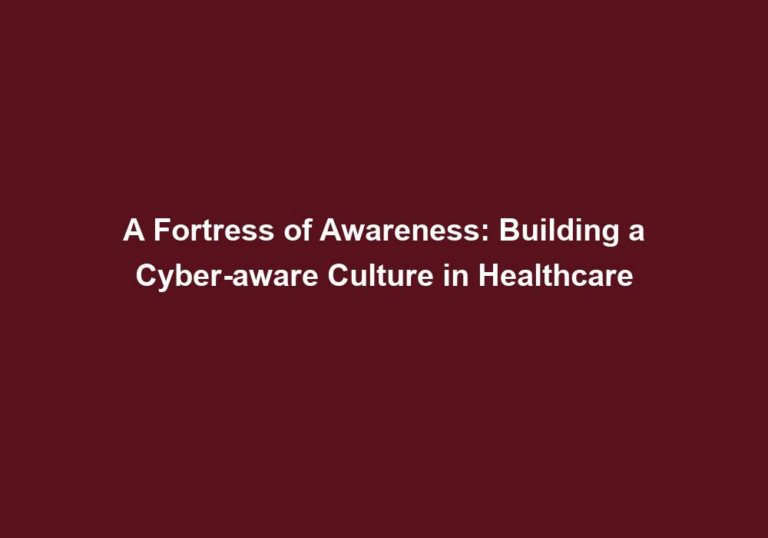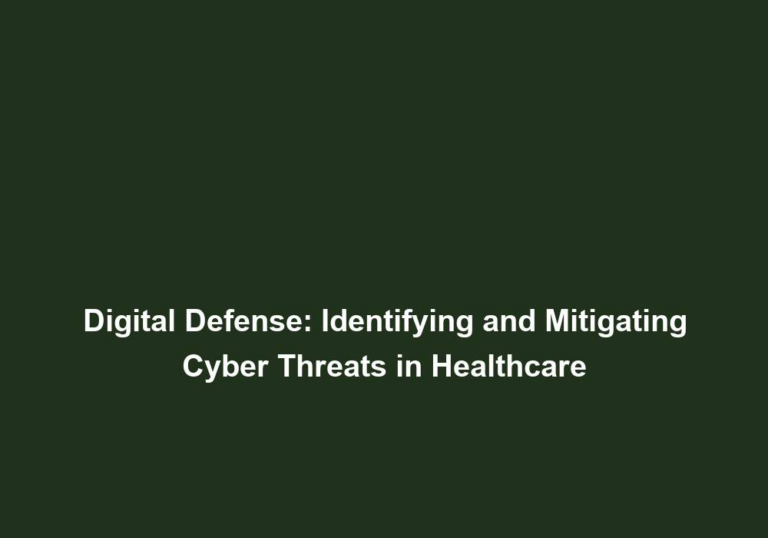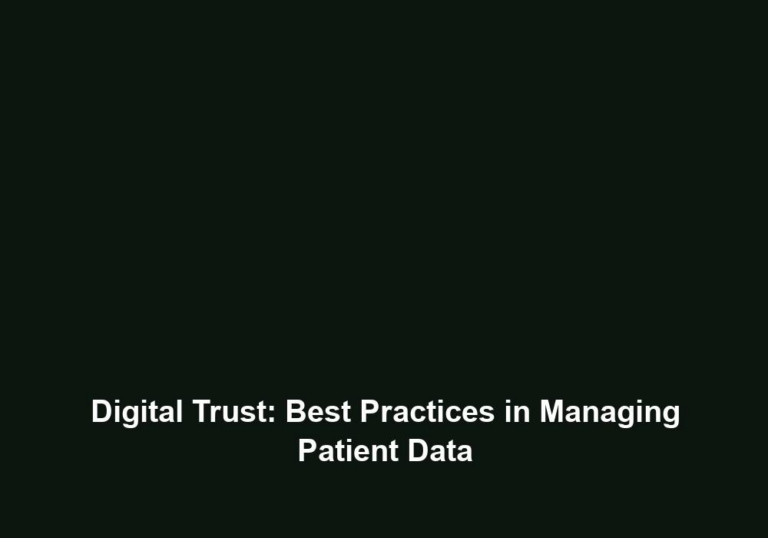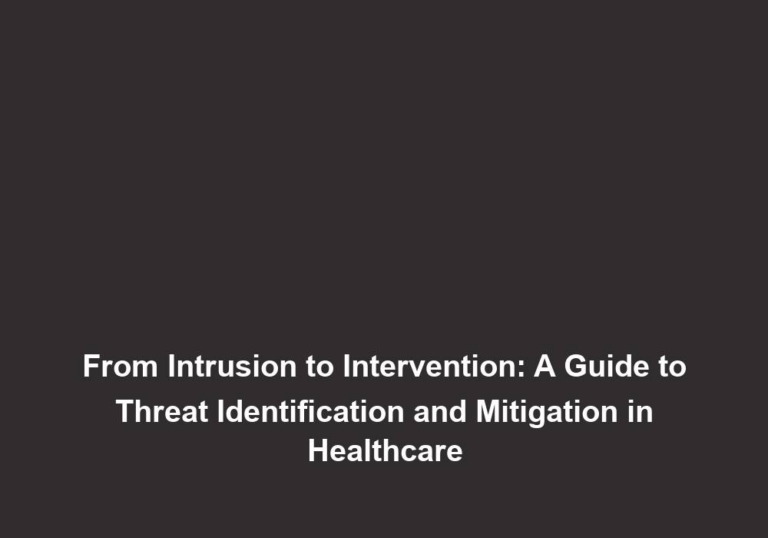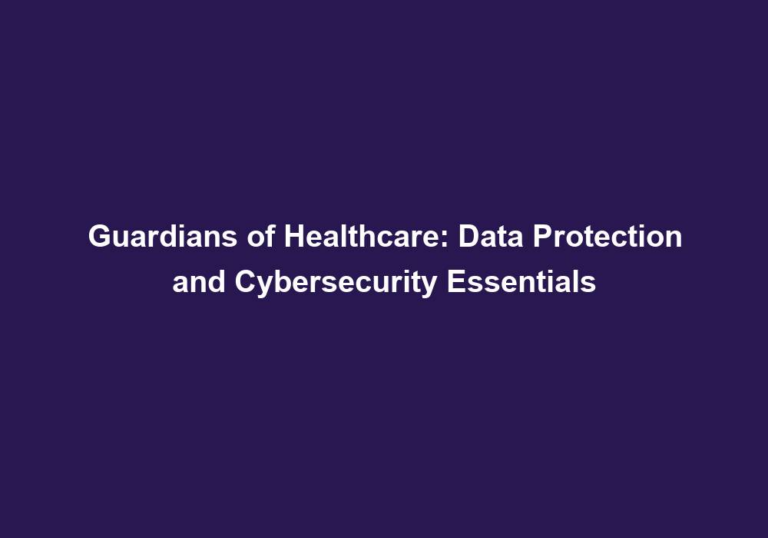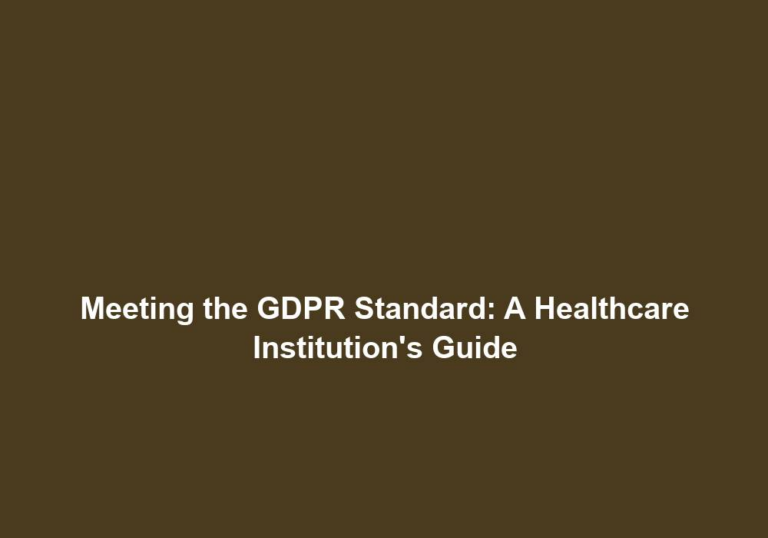Knowledge as a Shield: The Role of Training and Awareness in Health Data Protection
In today’s digital age, where technology has become an integral part of the healthcare industry, the protection of sensitive health data has become a paramount concern. With numerous data breaches and cyberattacks occurring globally, it is crucial for healthcare organizations to prioritize the training and awareness of their staff regarding health data protection. By equipping employees with the necessary knowledge and skills, healthcare organizations can create a shield against potential threats and ensure the confidentiality, integrity, and availability of health data.
Why is Training Important in Health Data Protection?
- Preventing Data Breaches: Training employees on best practices for data protection can significantly reduce the risk of data breaches. By educating staff about the importance of secure passwords, proper handling of electronic devices, and identifying phishing attempts, healthcare organizations can empower their workforce to act as the first line of defense against cyber threats.
- Employees should be trained on the creation of strong, unique passwords that are difficult to guess. Password hygiene practices, such as regular password updates and avoiding password reuse, should also be emphasized.
- Proper handling of electronic devices, including laptops, smartphones, and tablets, should be taught to prevent physical theft or unauthorized access to sensitive data.
- Training employees to recognize common signs of phishing attempts, such as suspicious emails or links, can help them avoid falling victim to these scams.
- Compliance with Regulations: The healthcare industry is subject to various regulations and standards, such as the Health Insurance Portability and Accountability Act (HIPAA) and the General Data Protection Regulation (GDPR). Training employees ensures that they are aware of their responsibilities in safeguarding patient information, thereby helping organizations maintain compliance and avoid costly penalties.
- Training programs should provide a comprehensive understanding of the applicable regulations and standards, including the specific requirements outlined in HIPAA and GDPR.
- Employees should be educated on the importance of obtaining patient consent for data collection, storage, and sharing, as well as the proper procedures for handling and disposing of sensitive data.
- Regular updates and refreshers on regulatory changes should be incorporated into training programs to keep employees informed and compliant.
- Mitigating Internal Threats: While external threats often make headlines, internal threats can pose significant risks to health data security. Employees with access to sensitive data must receive training on privacy policies, confidentiality agreements, and the potential consequences of unauthorized data access. By fostering a culture of security awareness, healthcare organizations can minimize the risks posed by insider threats.
- Training programs should emphasize the importance of maintaining patient confidentiality and the legal and ethical obligations associated with handling sensitive health data.
- Employees should be educated on the potential consequences of unauthorized data access, including disciplinary actions, legal liabilities, and damage to the organization’s reputation.
- Regular reminders and reinforcement of privacy policies and confidentiality agreements can help instill a sense of responsibility and accountability among employees.
Key Components of an Effective Training Program
- Baseline Training: All healthcare employees, regardless of their roles, should undergo baseline training on health data protection. This training should cover the fundamentals of data security, including password hygiene, safe email practices, and recognizing social engineering attacks. Regular refresher courses can help reinforce these principles and keep staff updated on emerging threats.
- Baseline training should include detailed instructions on creating strong passwords, including the use of a combination of letters, numbers, and special characters. Employees should also be educated on the importance of not sharing passwords and the risks associated with weak passwords.
- Safe email practices should cover topics such as avoiding clicking on suspicious links or opening attachments from unknown sources. Employees should be trained to verify the authenticity of emails before providing any sensitive information.
- Recognition of social engineering attacks, such as phishing, should be a key focus. Training should teach employees how to identify common tactics used by cybercriminals, such as urgent requests for personal information or impersonation of trusted individuals.
- Role-Specific Training: Different job roles within a healthcare organization have unique responsibilities when it comes to data protection. Training programs should address these specific roles, such as IT administrators, clinicians, and administrative staff. Tailoring the training to each employee’s role ensures that they understand their specific obligations and can effectively contribute to data protection efforts.
- IT administrators should receive specialized training on network security, data encryption, and system vulnerability management. This includes understanding the importance of regular software updates, implementing strong firewalls, and conducting periodic security audits.
- Clinicians should be trained on the proper handling and storage of patient records, including the use of secure electronic health record systems and the encryption of data during transmission.
- Administrative staff should receive training on privacy policies, data access controls, and the importance of maintaining accurate and up-to-date records.
- Simulated Phishing Exercises: Phishing attacks remain a common tactic used by cybercriminals to gain unauthorized access to sensitive information. Simulated phishing exercises can be an effective way to test employees’ ability to recognize and report phishing attempts. These exercises provide valuable feedback and allow organizations to identify areas where additional training may be necessary.
- Simulated phishing exercises should mimic real-world scenarios and include emails that closely resemble those used in actual phishing attacks.
- Employees should be encouraged to report suspected phishing emails and should receive immediate feedback on their actions. This helps reinforce the importance of staying vigilant and serves as a learning opportunity.
- Results from simulated phishing exercises should be analyzed to identify trends and areas of weakness. Additional training should be provided to address these vulnerabilities and enhance employees’ ability to detect and respond to phishing attempts.
- Incident Response Training: In the event of a data breach or security incident, a well-prepared incident response plan is crucial for minimizing the impact. Training employees on their roles and responsibilities during such incidents ensures a coordinated and efficient response. Regular tabletop exercises and simulated incident scenarios can help employees understand the steps to take in various situations.
- Incident response training should cover topics such as immediate actions to be taken in the event of a breach, escalation procedures, and communication protocols.
- Tabletop exercises, where employees participate in hypothetical scenarios, can help familiarize them with the incident response plan and identify any gaps or areas for improvement.
- Simulated incident scenarios, such as mock data breaches, can provide hands-on experience and allow employees to practice their response strategies in a controlled environment.
The Role of Awareness Campaigns
Alongside training programs, awareness campaigns play a vital role in emphasizing the importance of health data protection. By keeping data security top of mind, healthcare organizations can foster a culture where employees are actively engaged in safeguarding patient information. Some effective strategies for promoting awareness include:
- Regular Communication: Consistent communication regarding data protection policies, updates, and best practices helps keep employees informed and engaged. Newsletters, email reminders, and internal forums are effective channels for disseminating information and encouraging discussion.
- Regularly scheduled newsletters or email updates can provide employees with the latest information on data protection practices, emerging threats, and regulatory changes.
- Internal forums or discussion boards can facilitate knowledge sharing and encourage employees to ask questions or share their experiences related to health data protection.
- Reward and Recognition: Recognizing employees who demonstrate exemplary commitment to data protection can serve as a powerful motivator. Acknowledging their efforts publicly and rewarding them for their vigilance reinforces the importance of data security and encourages others to follow suit.
- Reward programs can include incentives such as bonuses, gift cards, or other tangible rewards for employees who consistently adhere to data protection policies and report potential security risks.
- Publicly acknowledging individuals or teams for their contributions to data protection efforts can create a sense of pride and encourage others to actively participate in safeguarding health data.
- Training Metrics and Progress Tracking: Monitoring training metrics, such as completion rates and quiz scores, allows organizations to assess the effectiveness of their training programs. Tracking progress and providing feedback to employees helps identify areas for improvement and ensures continuous learning.
- Training programs should include assessments or quizzes to evaluate employees’ understanding of key concepts and identify areas that require additional training or clarification.
- Regular progress tracking can help organizations track the overall compliance of their workforce and identify individuals or departments that may need additional support or training.
- Reporting Channels: Establishing clear reporting channels for security incidents or suspicious activities encourages employees to report potential breaches promptly. Anonymity and non-retaliation policies should be in place to create a safe environment for reporting concerns.
- Healthcare organizations should provide multiple reporting channels, such as dedicated hotlines or secure online forms, to ensure employees have convenient and confidential methods to report security incidents.
- Anonymity and non-retaliation policies should be clearly communicated to employees to alleviate concerns and encourage reporting without fear of reprisal.
In conclusion, knowledge acts as a powerful shield in the protection of health data. By implementing comprehensive training programs and awareness campaigns, healthcare organizations can empower their employees to safeguard patient information against potential threats. Training should be ongoing, role-specific, and supported by simulated exercises to ensure preparedness for real-world incidents. With a culture of security awareness, healthcare organizations can build a robust defense system that prioritizes the confidentiality, integrity, and availability of health data.
(Please note that while I strive to provide accurate and helpful information, I am an AI language model and should not be considered a substitute for professional advice in the fields of SEO or content writing.)


